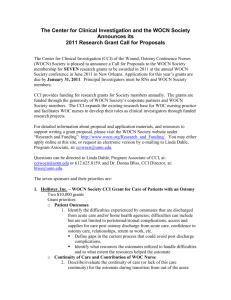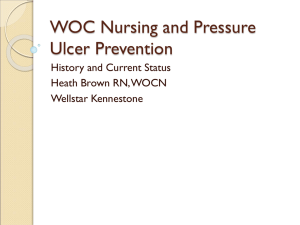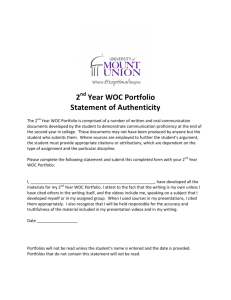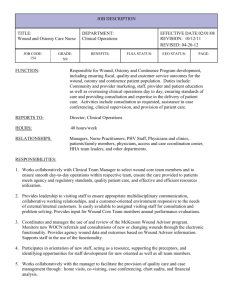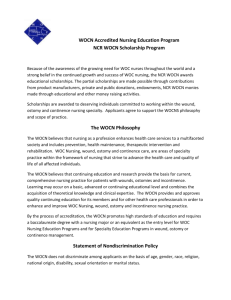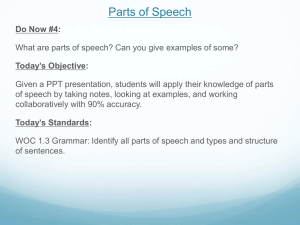Federal Register - Wound, Ostomy and Continence Nurses Society
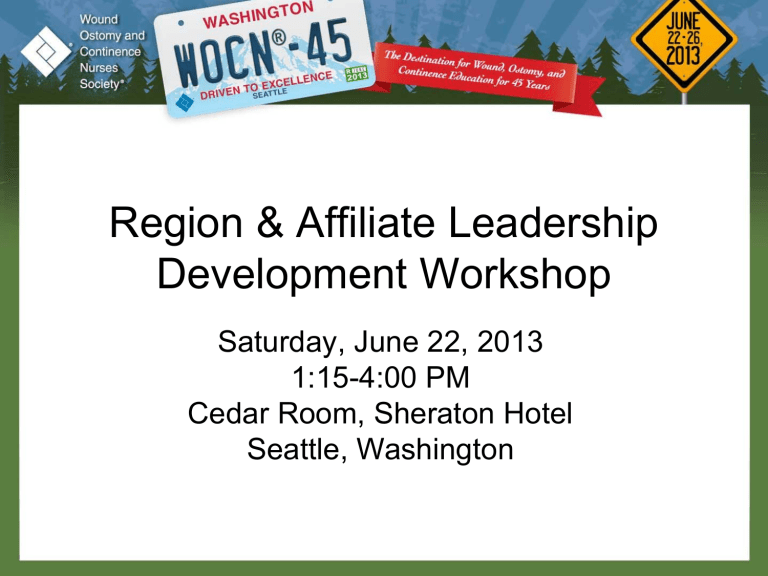
Region & Affiliate Leadership
Development Workshop
Saturday, June 22, 2013
1:15-4:00 PM
Cedar Room, Sheraton Hotel
Seattle, Washington
Objective
Gain an understanding of various elements of the current political landscape and the effect on Healthcare
Obtain an overview of current ANCC process, rules and regulations
Acquire an understanding of how to brand the WOCN logo and
WOCN Society image
Obtain an understanding of current tools available to demonstrate the value of a WOC Nurse.
Demonstrating the Value of the WOC
Nurse : The Difference is in the
Evidence
In 2009, the WOCN Board and Committee
Chairs and staff embarked on the development of a strategic plan centered around the creation of tools and messaging to demonstrate the value of the WOC Nurse
To achieve our overarching goal and communicate our value, the Society created and invested in the following tools and initiatives
Empowering
Designed to provide members with tools to communicate and demonstrate the value of WOC nurses in various practice settings
Scope & Standards of Practice
2012 Salary Survey
CNO Presentation
Productivity Template for Home & Acute Care
WOCN Brochure “ Recognize the Difference ”
• Defining the Practice
Positioning of the WOC Nurse
Wound Treatment Associate (WTA)
Educational program that provides a WOCN approved certificate of education in basic wound care
Is it a Pressure Ulcer or Incontinence Associated
Dermatitis (IAD)? An Introduction to Moisture
Associated Skin Damage
Wound Care: Principles of Wound Healing and
Product Selection
Ostomy Basics: Identifying Stoma Types and
Mastering Pouch Selection
Tools for Value
“Recognize the Difference”
Outcome Study purpose
Describe the prevalence, incidence and effectiveness of home health care agencies ’ services (with and without a WOC nurse) related to wounds, incontinence, and urinary tract infection (UTI) patient outcomes
Series of articles
Published in Jan/Feb
Published in March/April
Outcome Study Findings:
The Effectiveness of the WOC Nurse
Home Health Agencies with a WOC nurse had significantly better outcomes for both improvement and stabilization of wounds, urinary and bowel incontinence and UTI ’s compared to agencies with no WOC nurse
JWOCN Westra, et al Volume 40 Number1
Print, email and web banner ads
Publication / Medium Timeline Reach
AONE Voice of Nursing
Leadership newsletter print ad
January 2013 8,100 subscribers
AONE website banner ads January 2013 35,000 pageviews/month
December 2012 – January 2013 100,000 impressions American Journal of Nursing
(AJN) website banner ads
AJN eTOC email banner ad January 2013 24,000 subscribers
December 2012 – January 2013 9,500 subscribers Wolters Kluwer Executive Extra eNews newsletter ad
Journal of Nursing
Administration (JONA) print ad
(full page)
JONA iPad app cover band
January 2013
January 2013
10,100 subscribers
10,100 subscribers
Collaboration with the WOCNCB
®
“ Entry Level Wound, Ostomy and
Continence Nurse Education and
Certification ”
WOCN Society and WOCNCB
Joint Position Statement
Available at: http://www.wocncb.org/pdf/positionstatements/WOCNCB_Joint_Position_Statement.pdf
“ Marketing the Gold Standard:
Educating Others About WOCNCB
Certification ”
Power Point presentation by Mikel Gray,
PhD, FNP, PNP, CUNP, FAANP, FAAN
Available at: http://www.wocncb.org/resources/marketingresources/market-your-certification.php
Collaboration with the WOCNCB
®
Videos conveying the value of the WOC nurse
Available at: http://www.wocncb.org/video-contest/
• Collaboration with the
WOCNCB ®
Available at: http://www.wocncb.org/become-certified/how_to_choose.pdf
WOCN Image & Branding
Wound, Ostomy and Continence Nurses
Society™
The WOCN ® Society
WOCN
®
Branding 101:
Everything You’ve Ever Wanted to Know about Branding but Were Afraid to Ask
Kim Karagosian, Director of Marketing
Kaitlin Wingard, Marketing Manager
No longer just a way to “steak” your claim
What is a Brand?
What is a Brand?
"A Brand is not a product or a promise or a feeling. It's the sum of all the experiences you have with a company."
– Amir Kassaei, President, Art Directors Club of Europe
What is a Brand?
Everyone’s got a definition…
1. “A brand is the ‘personality’ of a product, service or company.”
2. “A brand is the essence or promise that a product, service or company will deliver or be experienced by a buyer.”
What is a Brand?
"It's not what you do once in a while; it's what you do day in and day out that makes the difference."
– Jenny Craig
What makes up a Brand?
• Logo/Identity
• Colors
• Name
• Acronyms
• Products
• Writing Style/Voice
• Domain name
• Trademark
• Relationships
• Feelings/Opinions
• Presence
• Performance
• Trustworthiness
• Quality
• Value
• Relevance/Point of
Difference
WOCN Society’s Brand
WOCN Society’s Brand
Regions & Affiliates: Brand Advocates for the WOCN Society
• As Regions and Affiliates, you are a large part of the Society
• We rely on YOU to help us get the word out about WOCN Society
• It’s important that our communications are consistent
Tips for Improving Your R&A Website
Ask your web designer/ developer to incorporate these colors into your website design.
Include the Mission and Visions on Your
Website
Mission
The Wound, Ostomy and Continence Nurses Society™ (WOCN®) is a professional nursing society, which supports its members by promoting educational, clinical, and research opportunities to advance the practice and guide the delivery of expert health care to individuals with wound, ostomy and continence concerns.
Include the Mission and Visions on Your
Website
Marketing & Communication : The WOCN Society will effectively deliver the message of our vision to our internal and external consumers to meet/exceed their needs.
Research: The WOCN Society will be the driving force in promoting research to enhance WOC clinical practice.
Volunteer Engagement: The WOCN Society will be a thriving organization of diverse WOC nursing leaders.
Education : The WOCN Society will be the leader in comprehensive, innovative WOC education that promotes safe and effective prevention and management of WOC disorders.
Membership : Every provider of WOC specialty nursing care is a member of the WOCN Society.
Advocacy: WOCN will be the authoratative voice promoting awreness among the public policy makers and the healthcare community about the prevention and maangement of WOC disorders.
Refer to the Society in a
Consistent Way
• On first mention: Wound, Ostomy and Continence
Nurses Society ™ (WOCN ®)
• On subsequent mentions: The WOCN Society or The Society
• Remember: WOCN should be used as an adjective, not a noun.
• Nurses are Wound, Ostomy and Continence (WOC) nurses, not
WOCNs
Branding Review: The WOCN
Society Style Guide
Review the new style guide for more information on branding with the
WOCN Society in mind.
ANCC
Overview of ANCC Criteria: Accredited vs.
Approved
Obtaining CE Approval
ANCC Form & Process
Commercial Support
Public Policy & Advocacy: The
Political Landscape
WOCN Advocacy Training
Presented by:
Christopher Rorick, M.P.A., Sr. Policy
Advisor, Bryan Cave
Who is Bryan Cave?
• Bryan Cave LLP is a leading business and litigation firm with global reach, a strong reputation and a long history of success.
• With more than 1,100 attorneys and 19 offices worldwide, we pride ourselves on proactive, solution-oriented work in every major area of interest to clients.
• Bryan Cave provides government relations and strategic counsel to corporations, trade associations and non-profit organizations.
What We Do
• The lawyers and non-lawyer consulting professionals on our team represent clients before a variety of federal regulatory agencies, the United States Congress, state legislatures, governors, attorneys general and county and municipal governments. Our team also assists clients on regulatory compliance, adjudication and rulemaking proceedings, enforcement actions and the drafting of agreements.
How We Do It
• BCS principals have extensive experience in helping manage political campaigns and legislative game-plans.
• This allows us to use campaign methodologies and techniques to design and execute winning strategies.
• Working in tandem with our colleagues in the firm ’ s other practice groups, we are uniquely capable of utilizing the “ toolbox ” approach.
• We provide clients with the full spectrum of government relations ’ services.
• Our firm also has an active political action
How We Do It
• Bryan Cave offers clients an unsurpassed bipartisan, bicameral team.
• We have long-standing relationships on both sides of the political aisle— in leadership, the relevant committees, the various key caucuses, and in the Executive Branch.
• We have worked closely with the congressional committees with jurisdiction over health care matters.
• We know and are respected by the Members of those committees and their staffs and are often called upon to serve as a resource to them.
Legislative & Regulatory Process
Types of Legislation
• H.R. - House Bill
• S. - Senate Bill
• H.J.Res. - House Joint Resolution
• S.J.Res. - Senate Joint Resolution
• H.Con.Res. - House Concurrent Resolution
• S.Con.Res. - Senate Concurrent Resolution
• H.Res. - House Simple Resolution
• S.Res. - Senate Simple Resolution
Regulatory Process
PreRule Stage
• Unified Agenda . The Unified Agenda is a collective list of all federal agencies' planned and recently completed regulatory actions. published semiannually, usually in April and October. Unified Agenda entries usually include, among other things: the title of the rule, an abstract, the submitting agency, the date of submission, the stage of the rule
(proposed or final), and the legal authority (when applicable). Current and past Unified Agendas are available electronically at RegInfo.gov
.
• The Unified Agenda often publishes rules in the "prerule" stage.
Usually, these rules have not previously appeared in the Federal
Register. Therefore, inclusion in the Unified Agenda is the first public notification of rulemakings.
• In the prerule stage, the rule will be assigned a regulation identifier number (RIN). The RIN is the easiest way to search for more information on agency websites or in the Federal Register. However, it is possible the agency will make no further information on the rule available until the agency publishes a notice of proposed rulemaking
(NPRM) in the Federal Register.
• The prerule stage also marks the opening of a rulemaking record.
However, the amount of information in the record made publicly available varies from agency to agency. The rulemaking record may be opened to the public in the prerule or proposed rule stage.
Regulatory Process, cont.
Proposed Rule Stage
• Before agencies can publish proposed rules, they submit significant rules to the White House for review. This provides the next opportunity for the public to view a proposed regulatory action.
• In addition to housing the Unified Agenda,
RegInfo.gov provides information on the review of proposed rules. When an agency submits a rule for review, the rule is posted on
RegInfo.gov. After the White House completes the process, it notes the outcome of its review.
• Users can search RegInfo.gov only by agency.
RegInfo.gov also provides a list of regulatory reviews completed in the last 30 days and historical reports of regulatory reviews.
Regulatory Process, cont.
Comments on Proposed Rules
• After the White House completes its review process, and if it allows the agency to continue with the rulemaking, the agency will publish a Notice of Proposed Rule
Making (NPRM) in the Federal Register. The NPRM should contain all the information essential for the public to understand the potential impact of the proposed rule. The NPRM usually announces the beginning and end of a notice-and-comment period for the rule.
• When the comment period for a proposed rule begins, the rule will be posted on Regulations.gov
, this is the federal portal for submitting public comments on rulemakings.
•
Regulatory Process, cont.
Final Rule Stage
• When the comment period ends, the process for tracking a regulation once again becomes murky. Although the rule, comments, and other information will remain on Regulations.gov
, new information may not become available until publication of the final rule.
• The Federal Register is another way of finding new information on a rule after the comment period closes. Agencies may publish relevant information as it comes up. Unfortunately, sorting through the many pages of the Federal Register is no small task.
• Another way of using the Federal Register is checking new Unified
Agendas. Because the Unified Agenda is published twice every year, rules frequently appear in more than one Agenda. Tracking a rule in the Unified Agenda will likely tell you no more than if the rule has moved from the proposed rule stage to the final rule stage.
• However, the fall publication of the Unified Agenda also includes the Regulatory Plan. The Regulatory Plan is more focused than the
Unified Agenda and includes only agencies' most important regulatory actions. If the rule you are tracking appears in the
Congressional Outreach
The Basics
• Congress
– House of Representatives (435
Members)
– Senate (100 Members)
• Locate Your Representatives
– www.house.gov
– www.senate.gov
• Do Your Legislative Research
– www.congress.gov
Congressional Office Makeup
• Member of Congress
– Chief of Staff
– District Director
– Legislative Director
– Legislative Aide
– Scheduler
Reaching Out
After Finding Your Representatives:
– Call their office and ask for the name of the Legislative Aide (LA) who handles health care issues
– Ask for their contact information
– Send introductory email to the Health
LA
– Follow-up as needed
Methods of Communication
• Preferred method is email communication
• Send to generic address first
• Send directly to Health LA if possible
• Keep it short and simple
• Avoid multiple messages
• Allow ample time for response
Building A Relationship
• Each Congressional Office has offices in the state as well as in D.C.
• District Staff
– Call District Director and ask for a meeting
– Tell them about your facility
– Ask them to help you schedule a visit to your facility
– Arrange a visit to your facility by the member of Congress
Visiting D.C.
• Notify WOCN Staff if you plan to visit
D.C.
• Contact Scheduler to arrange a meeting with the Member
• Notify Health LA of your plans as well
• Prepare for the meeting
• Do personalize everything
• Do tell your story
• Do thank them
• Do have support materials
• Do be flexible
• Do have an ask
Do ’ s & Don’ts
• Don ’ t assume they know anything about your profession
• Don ’ t bring in personal politics
• Don ’ t discuss fundraising
• Don ’ t be intimidated
Nurturing The Relationship
•Stay connected
•Pass along articles or studies
•Let them know you ’ re watching
State Advocacy
• Stay Alert – Try to read about the activities of your state legislature in the newspaper or on health policy blogs that might be available in your state.
• Engage Other Stakeholders – Reach out to patient group leaders in your state as well as the public policy representatives you might have at your institution and ask that you be kept involved and considered a resource on health policy decisions.
• Research – Two great resources are listed below that can help you become well informed about state policy and your state legislatures. The
National Conference of State Legislatures (NCSL) has a wealth of information about state policy and state legislators, and has a dedicated
Health Policy section.
• In addition, Project Vote Smart can help you identify who your state legislators are and how to contact them.
– http://www.ncsl.org/issues-research/health.aspx
WOCN Advocacy In Action
Recent Activities
• Advocacy Tab Rebuild
• Grassroots Communication Plans
• Ostomy & Fistula Working Group
– Comprehensive CMS Fistula Policy
– CMS Denial of Ostomy Supply Claims
– NY Ostomy Reimbursement
• HHS Partnership for Patients
• Stoma Site Marking
• Ostomy Guiding Principles
• Nursing Workforce Issues
• Home Health Orders for NP’s
• National Quality Forum
• CMS Competitive Bidding Program
Educating the Policy Makers
WOCN Health Care Agenda
Access to WOC
Supplies
Payment Reform
Nursing Workforce and
Education
Quality of Care
Initiatives
Public Policy and Advocacy
Understanding Medicare Part B Incident to Billing
Reimbursement of Advanced Practice Registered
Nurse Services
Continued alliance with the ANA
National Quality Forum Member
GI/GU Steering Committee
Achievements
Public Policy & Advocacy
Initiatives
Working with WOCN legislative consultant and UOAA on issues with local coverage decisions regarding ostomy supplies
Participating in NQF and quality measure development
Collaborating with ANA as an Organizational
Affiliate and participating in the Alliance of
Nursing
Ostomy Guiding
Principles
Joint Commission
Stoma Siting
Ostomy Supplies
Reimbursement (NY
& CA)
